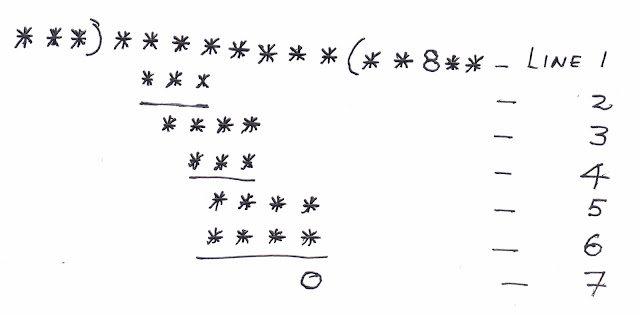I am stating the puzzle again, to which I can refer easily
as I proceed to solve it.
I could easily have given the solution at one go. But, after
reading Judge
Sachs assessment of the processes he uses in writing his final judgment, I
feel I should take my readers through the process I went through. Hence, this
will be a long, and possibly long winded post. Please bear with me.
It was after considerable time I spent staring at all those
asterisks I hit upon one clue. A five digit number multiplied by a three digit
number gives rise to an eight digit number. There can be no carry over in the
last step of multiplication.
But, before I proceed further, I need to make some
preparations. I am going to write down the given first line of the problem as:
a
|
b
|
c
|
)
|
d
|
e
|
f
|
g
|
h
|
i
|
j
|
k
|
(
|
l
|
m
|
8
|
n
|
o
|
All those asterisks were jumbling my mind. I am OK with the letters.
Looking at Line 3, it suddenly hit me that ‘m’ must be zero.
Otherwise, why the double drop down onto line 3? Likewise, then, ‘n’ also has
to be zero. The problem can now be rewritten as:
a
|
b
|
c
|
)
|
d
|
e
|
f
|
g
|
h
|
i
|
j
|
k
|
(
|
l
|
0
|
8
|
0
|
o
|
Then, it took me a while, indeed a long time, to leverage
the information contained in line 4. Line 4 in the body of the long division is
the product of ‘8’ and ‘abc’ (as a three digit number). As this is a 3 digit
number, ‘abc’ has to be less than 125. I stored away this piece of information for
possible use later.
Going to line 1, and 2, I find the difference is a two digit
number. Therefore, if ‘l’ is the maximum value 9, then ‘abc’ cannot be greater
than 110. But, if ‘abc’ is 110 or anything less, the difference between line 3 and 8 x ’abc’ (given in line 5) cannot be a two digit number. Hence, ‘l’ is not
9.
Then, I go back to line 3, just to see whether there is more
information hidden, that I missed the first time round. Line 3 to Line 4 back
to Line 3, not quite so tick-tock linear! The difference between ‘defg’ and ‘l’
x ‘abc’ is a two digit number, implying that ‘defg’ is a low four digit number!
Another piece of information, maybe it would turn out to be useful later.
As my basket of information is filling up, I gained some confidence
that I am on the right track.
I had a look at ‘l’ again. If ‘l’ is less than 8, say 7, and
if ‘defg’ is taken to be the smallest four digit number, that is, 1000, then I
find that 1000-7x124 = 132, a three digit number! Not possible. Therefore ‘l’
can be only 8.
We already know that ‘abc’ cannot be greater than 124. If we
prove that ‘abc’ cannot be less than 124, one more step in the solution would
be completed. This is very easy to do. Take ‘o’ as 9, and check out 123 x
80809. We get 9939507, a seven digit number! So, ‘abc’ cannot be 123. ‘abc’ is 124.
What remains is to find ‘o’ such that 124 x 8080’o’ is an eight
digit number. Recall that 8 x 124 is a three digit number and line 6 shows a
four digit number. Hence, ‘o’ is 9.
So, the line, in its totality is,
1
|
2
|
4
|
)
|
1
|
0
|
0
|
2
|
0
|
3
|
1
|
6
|
(
|
8
|
0
|
8
|
0
|
9
|
One confession. I worked out much of the above in my mind.
But, to confirm the same I had to put them down on paper. Of course, it was all
a scribble and the justifications were mostly mental. The process is NOT AS CUMBERSOME
as the post shows. Yet, it is an INVOLVED process. Were I to have given only
the answer, I am sure readers would have treated it as trivia. But, with the
details of the arithmetic, as well as solving, the puzzle must have gained at least a
minimum level of admiration. This was the goal.


No comments:
Post a Comment